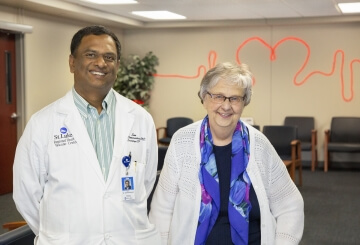Preventing Strokes with the Watchman Device
Published in the Woman Today magazine, June-July 2019 Issue
For those who can’t take blood thinners and are at risk of having a stroke, St. Luke’s now offers an alternative.
After waking up in a hospital bed surrounded by doctors, Two Harbors native Patty Olson was told that she was going to need a pacemaker. “I thought I was having a nightmare,” said Patty. “I had absolutely no idea that I had any heart issues at all.” She had just undergone surgery to treat a bleeding stomach ulcer, and during the operation doctors noticed her heart was in atrial fibrillation (AFib).
AFib is when the heart has an irregular heartbeat. This can complicate blood flow in the heart’s chambers and puts a person at a higher risk for having a stroke. A pacemaker can help regulate the heartbeat of a person with AFib, but it doesn’t eliminate the risk of stroke.
Blood thinners are typically prescribed to prevent blood clots from forming in people who have AFib. However, this anticoagulant therapy is not tolerated by everyone; this includes those who are older or have more than one chronic disease or condition. Until recently, this group of people was left without any treatment options and had to live with an increased risk of stroke.
Patty suddenly found herself in this position. Due to her bleeding ulcer, taking blood thinners would have been too dangerous. “My mother died of a stroke,” said Patty. “I was terrified that I would end up like my mom.”
Fortunately, St. Luke’s offers a new option to help protect people like Patty.
AFib and the risk of blood clots
The heart is made up of two side-by-side pumps. The right pump sends blood to the lungs to be oxygenated, and the left pump delivers this oxygenated blood to the rest of the body. Each pump is made of two chambers. The upper chambers are called atria, and the bottom chambers are ventricles.
When a heart is in AFib, the upper chambers of the heart beat irregularly. A wide range of factors can contribute to this condition including age, heart attack, high blood pressure or an overactive thyroid gland. Blood isn’t moved as effectively into the ventricles, and blood clots are more likely to form.
These blood clots tend to form in the left atrial appendage (LAA), a small pouch in the muscle wall of the left atrium.
“When atrial fibrillation happens, the left atrial appendage behaves more like a bag instead of a pump. Blood pools here and can become stagnant. This can lead to clots that may eventually break free and cause a stroke,” explained Dr. Porur Somasundaram (known to his patients as Dr. Som), an electrophysiologist with St. Luke’s Regional Heart & Vascular Center. “Before there was no alternative to blood thinners. Now there is one.”
The Watchman device
During a minimally invasive procedure, Dr. Som goes up through a vein to place a small device, known as the Watchman device, in the opening of the left atrial appendage (LAA). Eventually, tissue grows over the opening to permanently seal off the small pouch. This way, no blood can get in to pool, so the chance of blood clots forming is significantly reduced. The LAA is a very small part of the left atrium, and sealing it off does not compromise any of the heart’s functions.
“The Watchman essentially acts like a plug,” said Dr. Som. “It’s a very straightforward procedure. At St. Luke’s we’ve done 42 cases in the past year and all of these patients, besides two, went home the next day.”
This new option offers peace of mind to those who are at risk for stroke, like Patty.
“All I knew was that I wanted to be around,” she said. “My husband is 96 and as spry as can be. We have such a good life. I didn’t want to end up having a stroke, and because of the Watchman procedure I don’t have to worry about that anymore.”
Providing what you need at St. Luke’s
Dr. Som performed Patty’s Watchman procedure and she was able to go home the next day, feeling thankful for the team that cared for her at St. Luke’s. “They just make me confident,” said Patty. “They are such good doctors.”
Dr. Som’s vision is to continue offering specialized procedures like the Watchman in order to provide the most comprehensive care possible. “I strongly believe that everything my patients need has to be available at one single place,” he said. “This way their care is not fragmented. We can help each individual as a whole.”
If you or someone you know is in a similar situation to Patty, the Watchman procedure may be able to offer protection from the risk of strokes. Talk to your primary care provider or your cardiologist about this option. For more about St. Luke’s Regional Heart & Vascular Center, visit slhduluth.com/heart.
